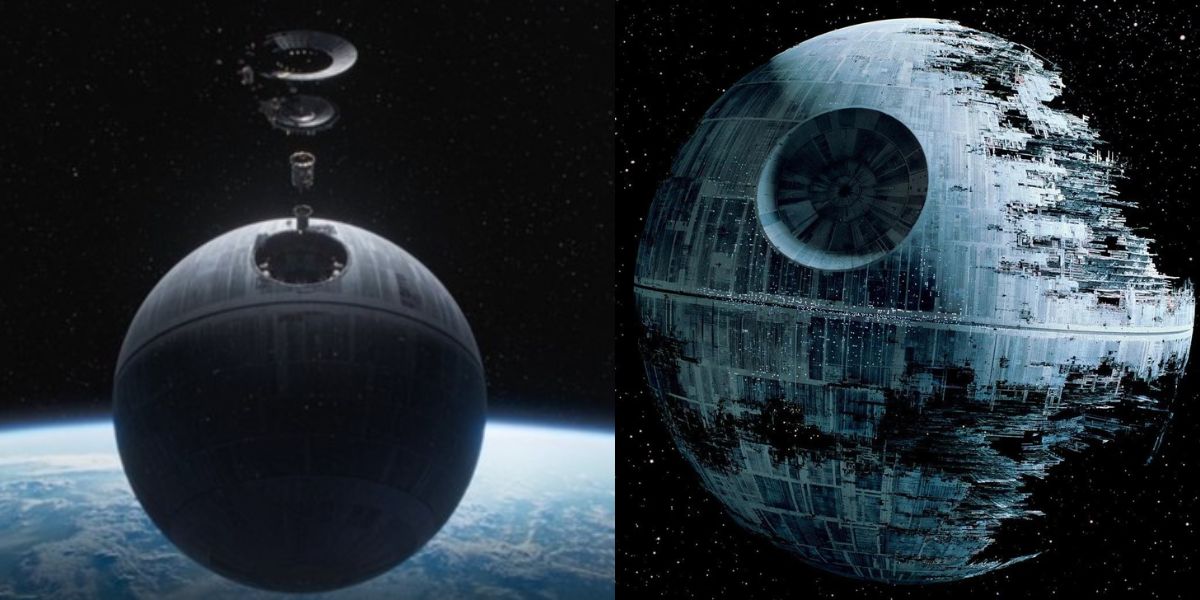The First and Second Death Stars were front and center in the original trilogy. They resembled one another but were built much differently. Why was that the case? We can point to advances in technology and intended plans for the answer.
How the Two Death Stars Were Constructed Differently
Death Star I was the “moon-sized” battle station that helped launch Star Wars. Palpatine and Director Krennic started forging it in the waning days of the Republic. As we witnessed in A New Hope, the First Death Star was “designed to fire a single planet-destroying superlaser” that took time to develop.
This Death Star was initially built while orbiting Geonosis and then shifted to Scarif. It took about 20 years to complete. The “unprecedented scale” of the project, advanced technology, and required resources help explain its lengthy construction.
The Death Star II was larger than the First Death Star and only partially completed before the Battle of Endor. Its superlaster was “the main priority” and was already completed and installed while the rest of the mammoth structure was still underway.
This short video provides insights into key improvements with the Second Death Star. The superlaser was more powerful and could recharge much faster than the first. This Death Star also did not have an internal exhaust port that could be exploited to blow it up. Instead, it had tube exhausts spread all over the surface.
Once completed, the Second Death Star would have been 200 kilometers in diameter with over 500 inner levels. As we know, though, the Rebels foiled the Empire’s plans, but what we saw in Return of the Jedi took about 4 years to complete
Why Were The Two Death Stars Built Differently?
Responses on this discussion provide an entryway into why the two Death Stars were built differently. Fans indicate how the First Death Star’s weapon represented “cutting-edge technology” that needed to be fully developed and installed last. In contrast, the second Death Star had the first one as a model to improve upon, and built and placed the superlaser first.
With Death Star I, the superlaser development was complicated and ended up being the most “time-consuming aspect” of its 20-year timeline. The technology was hard to get right. We also witnessed purposeful delays by Galen Erso in Rogue One that help explain why it was installed last.
The second superlaser for Death Star II was built more quickly because the Empire understood the technology better by that point. This weapon had “across-the-board improvements” from the first one, including a better targeting system to target Rebel ships. That capability gave us this Lando line about the Second Death Star being operational and quite deadly.
Fans and Wookieepedia also acknowledge how the Second Death Star was also left partially completed to lure the Rebels into battle. This was part of Palpatine’s plan to wipe out the Rebellion with the fully operational superlaser. The Rebels didn’t know it was ready, producing this famous line from Admiral Ackbar, “It’s a trap.”
Sidious’s plan helps explain not only why the Second Death Star was built differently but also why it was destroyed. As this article attests, Palpatine rushed “the construction and completion of the laser” to wipe out the Rebellion. Yet, Death Star II was left with “its innards” exposed and vulnerable to the Rebel fleet once its deflector shield was disabled.
Why Was the Third Death Star Constructed Differently?
About 30 years after the Second Death Star was destroyed, the third one took hold, Starkiller Base. This third superweapon could wipe out entire star systems and was built into the planet Ilum.
This First Order weapon was constructed into an “equatorial trench” that had developed from over-mining kyber crystals for the Death Stars. Starkiller represented a culmination of research into using energy from stars to channel dark energy or quintessence into an area within the planet’s core.
Because Starkiller was much more advanced than the two Death Stars, the First Order needed a planet-sized base for it and its more powerful fuel source. Nevertheless, the Resistance managed to destroy it.
Death Star I, II, and III
Because of technological improvements, Death Star I and II were built differently. Palpatine also left the Second Death Star intentionally incomplete to lure in the Rebels. Death Star III, or Starkiller, was constructed with even more advanced technology, but in the end, it met the same fate.

